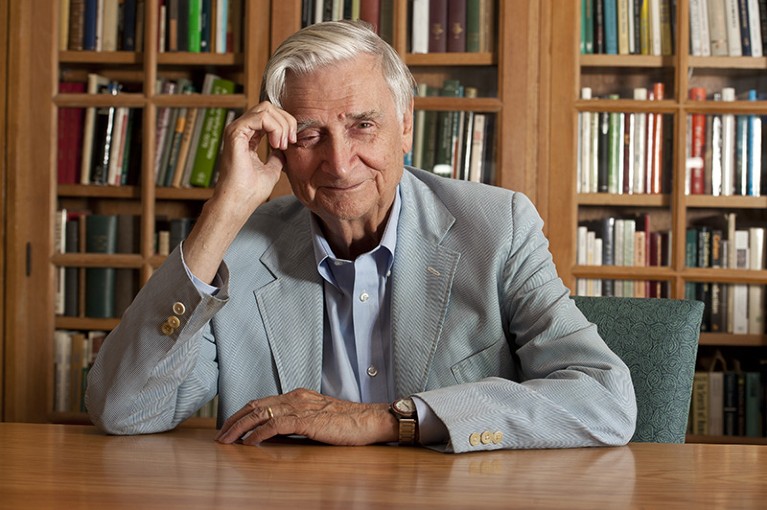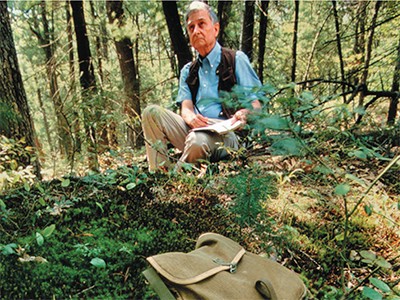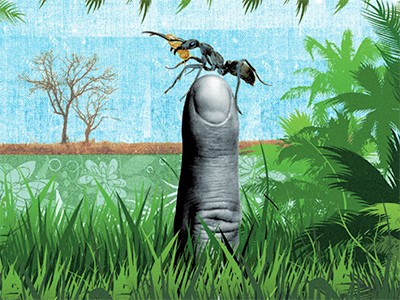
Harvard University Professor E.O. Wilson in his office at Harvard University in Cambridge, MA. USACredit: Rick Friedman/Corbis via Getty
Edward (Ed) Wilson began by exploring the systematics, geographical distribution, social organization and evolution of ants. He became one of the great scholarly synthesizers, winning two Pulitzer prizes. A superb naturalist who enjoyed challenging dogma, he fought for conservation, brought ideas of biodiversity into the mainstream and set ecology on a rigorous conceptual footing. He has died aged 92.
Wilson’s book Sociobiology, published in 1975, was the first to address the evolution and organization of societies in organisms ranging from colonial bacteria to primates, including humans. The final chapter, on human social interaction, ignited controversy. Wilson argued that human behaviour, although adaptable to environmental conditions, is rooted in a genetic ‘blueprint’. Opponents claimed that nothing in human behaviour is grounded in genetics, except sleeping, eating and defecation. In a letter to The New York Review of Books, a group of academics including evolutionary biologists Stephen Jay Gould and Richard Lewontin associated Wilson’s view with racism and genocide. Wilson responded with elegance and humour; in my view, most scholars now agree that he won this argument.
Wilson was born in 1929 in Birmingham, Alabama, and grew up, as he admitted in his 1994 autobiography, Naturalist, “mostly insulated from its social problems”. After studying biology at the University of Alabama in Tuscaloosa, he did graduate studies at Harvard University in Cambridge, Massachusetts. He felt its Museum of Comparative Zoology, with the world’s largest ant collection, was his “destiny”.
In 1955, he obtained his PhD on the systematics of the ant genus Lasius, which includes the widespread black garden ant. Systematic biology and the study of biodiversity remained his mission, but he made significant contributions to other fields, such as animal behaviour and chemical ecology. His early work on chemical communication in animals, particularly social insects, inspired a generation of scientists to explore a new area in behavioural physiology.
In 1954, Wilson set out for Melanesia, including New Guinea, to study ant taxonomy and biogeography. On the basis of his data, he elaborated the critique that he and his Harvard colleague William Brown had previously developed on the idea of subspecies. They argued that the distinctions between species should be more clearly defined, allowing for variability within species. Equally influential was their thinking on character displacement — when similar species in the same area diverge genetically to avoid competing for resources.
Through his fieldwork in Melanesia and later in the Caribbean, Wilson drafted a principle of biogeography that he called the taxon cycle. Species evolve back and forth between being able to live in marginal habitats, and thus disperse widely, and restricting their distribution to species-rich habitats in island interiors. He tested this and other original hypotheses in the Florida Keys in the 1960s, in collaboration with his former student Daniel Simberloff. With ecologist Robert MacArthur, he proposed that species maintain their populations through trade-offs between number of offspring and quality of parental care (the concept of r/K selection). Their 1967 book The Theory of Island Biogeography had far-reaching effects on studies of evolution and conservation.
From early in his career, Wilson wondered about ways to understand the evolution of social organization, from primates to social insects (such as honeybees and ants). “A congenital synthesizer,” he wrote in his autobiography, “I held on to the dream of a unifying theory.” He developed a theory of adaptive demography — that certain kinds of social structure might increase reproductive fitness — and the evolution of division of labour between castes, such as insect queens and worker groups. First brought together in The Insect Societies (1971), these concepts were elaborated in Caste and Ecology in the Social Insects, with mathematical biologist George Oster, in 1978.
Sociobiology was a much more far-reaching synthesis on the evolution of social systems. The furore that ensued stimulated Wilson to write an even more provocative book, On Human Nature (1978). This garnered his first Pulitzer. His highly original book Biophilia (1984) was the first to use the term to mean human empathy for the natural world. He argued that pleasure in being surrounded by diverse living organisms is a biological adaptation. These books prepared the ground for Consilience (1998), which one reviewer called a biologist’s dream of the unity of knowledge. It proposed the kind of intellectual annexation that occurs when one field can be explained in terms of a more fundamental discipline, and received a mixed response.
To his and my utmost surprise, in 1990, the huge monograph The Ants, on which we worked for years, won another Pulitzer. Wilson continued to publish on human evolution and humanity’s relationship with the planet into his 90s. Half-Earth (2016) is a passionate plea to leave half of our world to nature.
Ed was not a team builder. He preferred to work alone, although in a few cases he found colleagues who complemented his abilities. He thrived on controversy. In the past two decades, he had rejected the theory of inclusive fitness — the idea that the reproductive success of an individual increases when it helps to raise the offspring of its close relatives — that he once propagated. This led to heated debates, and I opposed some of his views. When we reached a compromise and submitted the manuscript of our book The Superorganism (2009), Ed’s concluding remark was: “Bert, there is one thing we agree on 100%. That is: my co-author is wrong.” One could disagree with Ed over scientific issues and remain good friends.



 Conservation: Glass half full
Conservation: Glass half full
 Ecology: Wilson in Africa
Ecology: Wilson in Africa
 Evolution of eusociality
Evolution of eusociality







